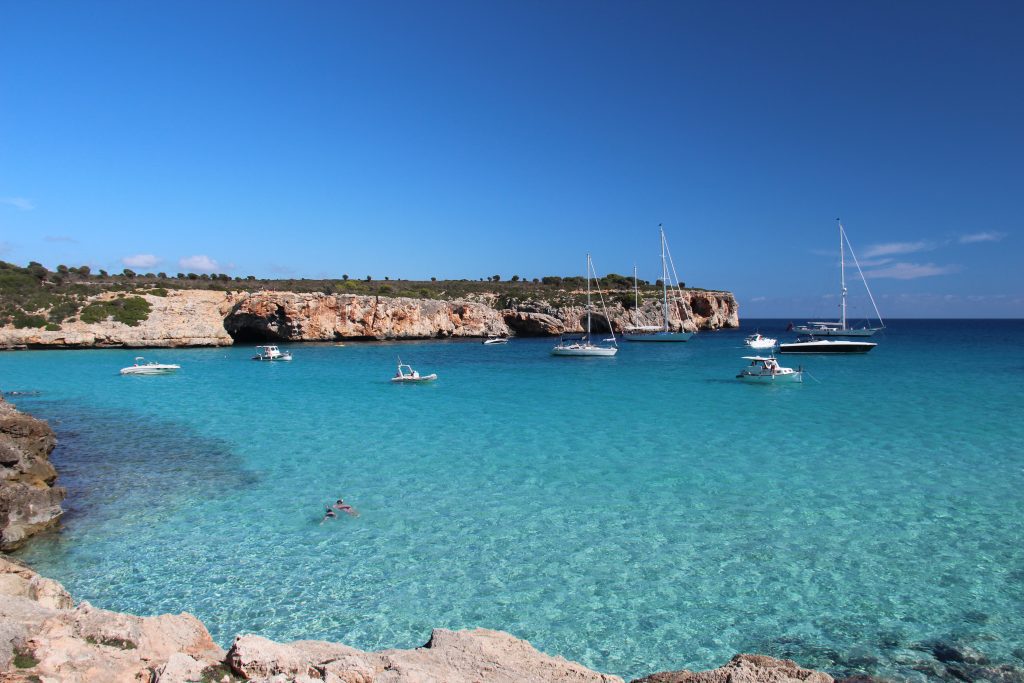If you haven’t read Part 1 of this series yet, you can find it here.
There’s a little something for everyone in Mallorca, and visitors of all preferences would be hard-pressed to get bored; the island offers enough variety to occupy even a longer visit of 2-3 weeks. Watersports of all kinds are on offer all along the coastline, of course, but there is much more. For nature lovers there are beautiful walking trails and hikes of varying degrees of difficulty, plus two smaller, unpopulated islands (Isla Cabrera and Sa Dragonera) which can be visited by boat. Several caves can also be visited on a rainy day (or to cool off on a hot day!), I can recommend Coves de Campanet in particular.



If you really want to burn some calories, Mallorca is a bicyclist’s paradise, particularly for road cyclists but mountain bikers can also find plenty of unpaved country roads and singletrack bike trails. Routes of varying length and difficulty are readily available throughout the island. The photo to the left is one of the bicycle lanes that meander through the wine country near Binissalem.
Finally, there are several more challenging hikes, particularly in the Tramuntana Mountains that run along the island’s west coast. Definitely top among them is the stunning Torrent de Pareis. Climbing gear is not needed but appropriate shoes, clothing and good physical fitness are an absolute must, and the gorge should never be entered when rain has recently occurred or is forecasted due to the risk of flash floods.
Navigating the canyon requires scrambling over, under and between large boulders, so you should also be comfortable with that – and of course bring plenty of water along, especially when it’s hot!





Mallorca’s also great for culture and history buffs. Traditional Mallorquin buildings practically beg to be photographed at every corner, the cathedral in Palma is a stunner, and there are even quite a few extremely well-preserved medieval structures and Roman archaeological sites (such as Pollentia) to explore. Given the relatively large permanent population there are also quite a few cultural centers for music, dance and theater, and there’s always a festival or two (or more!) happening somewhere.

Finally, the indulgence of food and drink available on Mallorca really cannot be overstated. Given its isolation from mainland Spain and various outside influences throughout its history, Mallorca has a cuisine all its own. From sobrasada (cured and spiced pork sausage) to Pica Pica (squid stewed in a spicy tomato sauce) or Tombet (potatoes, tomato, bell pepper and/or eggplant – vegan friendly!), dishes unique to the island blend together with well-known Spanish classics to create a mouth-watering assortment of flavors, rounded out by fantastic locally produced cheese, olives and olive oil.
And let’s not forget the drinks! If you like wine, you will be impressed with Mallorca’s high-quality assortment of both red and white varietals, some local and some internationally known. Finally, if herbal liqueur is your thing, you must try Hierbas! It’s available in sweet, dry and mixed (literally a mix of the two) varieties, and if you like the intensity of herbs in a liquor, you will love it!
Summer is definitely the high season but by no means is Mallorca only a summer destination – far from it! In fact, my two visits were in October and April, and I never felt like I missed out on anything…except for bigger crowds and more heat, that is. If you want to avoid high season but still want swimming temperatures, I’d recommend late September through early November, when the water is generally still in the low to mid 20’s C (low to upper 70’s F). But really, there is hardly a bad time to visit, just different possibilities depending upon the season. Christmastime enchants with decorations, seasonal markets and the traditional holiday atmosphere. February and March bring beautiful almond blossoms, Spring is gorgeous and generally already quite warm and sunny. Summer is – well, Summer – and as already mentioned Autumn is like Summer extended, except with fewer crowds and a bit less heat.


Finally, in the current covid-19 situation it’s important to mention that in comparison to some parts of Spain that have been quite hard hit, as of the publishing date of this entry Mallorca has had a very low rate of infections, thanks to both its geographic separation and the early shutdown of travel to the island. The authorities there have been working hard to ensure the safety of both residents and visitors now that tourism is able to start up again, and “test” tourism on a small scale is happening literally as I write this, to ensure that all systems are in place to react swiftly to any possible concerns.
The small rural hotels, fincas and vacation rental apartments and villas scattered around the villages of Mallorca are not only among the safest ways to stay when traveling currently, they are (in my humble opinion) also the overall best choices for this destination!
So, what are you waiting for?! Pick your season, and book your Mallorca escape!




